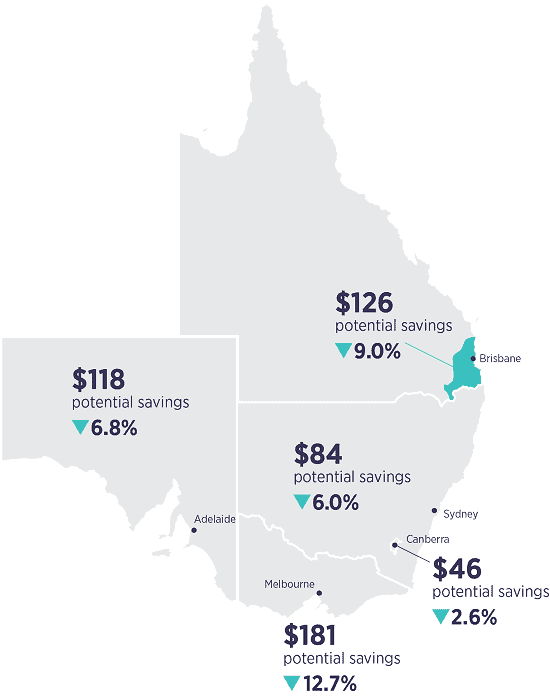Australia’s consumer watchdog has released new figures showing electricity prices have fallen almost 9 per cent since the middle of last year. As a result, there is a staggering $900 million in potential savings up for grabs for households in eastern and southern states.
Electricity prices fall across the National Energy Market
The ACCC calculated the significant benefit if all customers in NEM regions (SE Qld, NSW, Vic, SA and ACT) moved to the cheapest offers. They found total annual savings would be about $900 million compared to June 2020. For example, households in Victoria could expect average potential savings of $181 per annum, $126 in South East Queensland and $118 in South Australia. While NSW residents had average potential savings of $84 and $46 in the ACT.
Source: ACCC analysis of offers available in Energy Made Easy and Victorian Energy Compare
Electricity prices change course.
ACCC Chair Rod Sims said, “Prior to this, we had a decade of sustained electricity price increases that placed unacceptable pressure on households and small businesses”. Now things have changed. “A significant increase in generation capacity, attributed to renewable generation and falling fuel costs, has led to much lower wholesale electricity costs, and it’s vital that all Australians now see the savings.” Most of a consumer’s electricity bill is made of wholesale electricity and network costs. There’s been a decrease in wholesale spot market prices across all National Electricity Market regions in 2020-21. Compared to 2019, average wholesale spot prices have fallen by 58 per cent in Victoria, 49 per cent in South Australia, 43 per cent in New South Wales and 39 per cent in Queensland. “Spot prices have been significantly lower for a year now, so retailers should be experiencing significant reductions in their costs already”.How to get your share of savings
Mr Sims said, “There are two ways that households and small businesses can get the hip-pocket benefit of recent reductions in retailers’ costs: by changing to a new, cheaper plan; or, by waiting for their retailer to lower the rates on the plan that they’re already on,” “While we encourage consumers to cash in on the available savings by switching to a better deal, new laws require electricity retailers to pass on cuts in the wholesale cost of electricity.” stated Mr Sims. The new Prohibiting Energy Market Misconduct (PEMM) laws that came into effect in June 2020 require electricity retailers to make reasonable adjustments to their prices in line with their costs of procuring electricity. “If electricity retailers haven’t passed on the savings to consumers as required by law, in line with recent wholesale price reductions, they can expect to hear from us,” Mr Sims said. WATTever’s view is that even with legislation and protections such as the Default Market Offers (or VDO in Victoria), households who don’t engage in the electricity market end up consistently paying a higher amount for electricity than they could with a competitive market-based deal.Why wait to pay less for energy.
Followers of WATTever will have noted increased price competition over the last 12 months. Smaller energy retailers have been the primary drivers of lower-priced electricity offers and the first to pass on lower rates. As a result, independent and second-tier players have dominated the cheapest plan rankings. We’re yet to see any sizable shift in the competitiveness of the big three retailers publicly-listed offers. Want to find out how much your household could save? WATTever’s comprehensive energy comparison provides a strict price ranking of all publicly-listed energy offers based on your unique energy use. Use it to find and switch to a better deal or to have a well-informed conversation with your current retailer about matching the leading deals in the market.Share this article
Facebook
Twitter
LinkedIn

